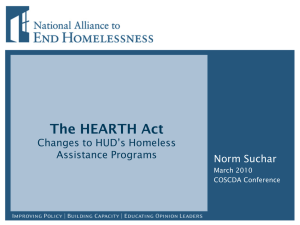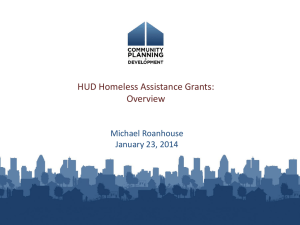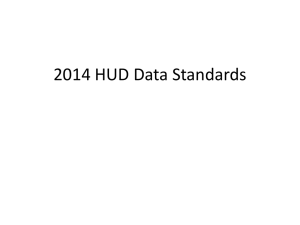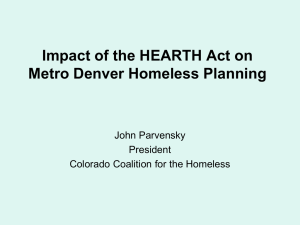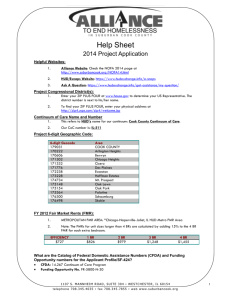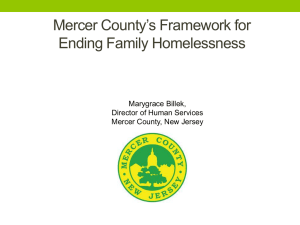System_Packet_Handout
advertisement
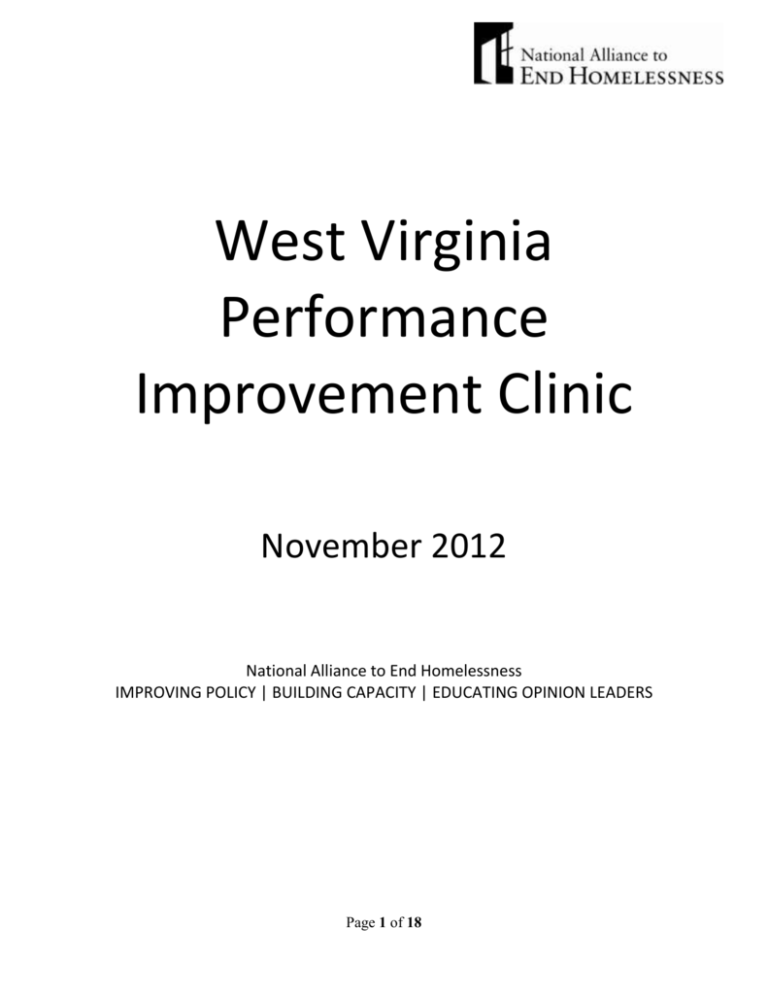
West Virginia Performance Improvement Clinic November 2012 National Alliance to End Homelessness IMPROVING POLICY | BUILDING CAPACITY | EDUCATING OPINION LEADERS Page 1 of 18 Page 2 of 18 The HEARTH Act Timeline New Homeless Definitions Implemented December 2011 Interim Regulations for Emergency Solutions Grants (ESG) posted December 2011 Interim Regulations for Continuum of Care (Supportive Housing Program) published in July 2012 (We are in the public comment period! Plan to Comment) HEARTH ACT: Emergency Solutions Grants (formerly Emergency Shelter Grant) Summary and Analysis of the Interim ESG Rule December 2011 On November 15, 2011, the U.S. Department of Housing and Urban Development (HUD) released an interim rule for the new Emergency Solutions Grant program, which was officially published in the Federal Register on December 5. The interim rule implements changes made by the Homeless Emergency Assistance and Rapid Transition to Housing (HEARTH) Act of 2009. HUD also published a final rule on “Defining Homeless” on December 5 and a draft regulation on the Homeless Management Information System (HMIS) on December 9. Regulations governing the Rural Housing Stability Program and the consolidated Continuum of Care (CoC) programs are expected in the coming months. Overview and Rationale for Interim Rule Congress passed the HEARTH Act in May 2009. Among other changes, the Act expanded the Emergency Shelter Grant by adding rapid re-housing, more robust homelessness prevention, and HMIS as eligible activities. The HEARTH Act also renamed the program as the Emergency Solutions Grant (ESG). It emphasized the importance of helping people to quickly connect with or remain in permanent housing after they experience a housing crisis or homelessness. HUD aims to help communities improve integration with mainstream services, strengthen system-level coordination, and build on lessons learned from years of practice and research to invest in proven solutions like rapid re-housing. Normally, HUD publishes a proposed rule, accepts public comments, and uses that feedback to release a final regulation that will go into effect. However, HUD has decided that it would be in the public’s best interest to begin implementation of the new ESG program as quickly as possible. This requires the use of an interim rule that will go into effect almost immediately, though HUD will still take public comments into consideration before publishing a final rule. While many federal program funding levels were reduced in fiscal year (FY) 2011, Congress specifically provided additional funding for the new ESG program. HUD interprets this to mean that Congress recognizes the need for homeless assistance and that the new ESG program can have an immediate impact on helping people experiencing and at risk of homelessness. Timing The regulation will go into effect on January 4, 30 days after it was officially published in the Federal Register. Page 3 of 18 Individuals and organizations are encouraged to submit comments to HUD to provide feedback on HUD’s interpretation of the HEARTH Act as it relates to the ESG program. Public comments are due February 3. HUD will subsequently publish a final regulation on the new ESG program. Definitions The interim ESG rule identifies three categories of people who are “at risk of homelessness” and are therefore eligible for homelessness prevention assistance. At-risk households include: 1. Individuals and families who have all three of the following characteristics: o Have incomes below 30 percent of area median income; AND o Have insufficient resources (i.e. family, friends, faith-based or social networks) immediately available to attain housing stability and avoid entrance into an emergency shelter or literal homelessness; AND o Exhibit one or more qualifying risk factors (see below for details). 2. Children and youth who qualify as homeless under other federal statutes, including the Runaway and Homeless Youth Act, Head Start Act, Violence Against Women Act, Public Health Service Act, Food and Nutrition Act, or Child Nutrition Act; AND 3. Children and youth (and their parents/guardians who live with them) who qualify as homeless under the Department of Education definition (Education for Homeless Children and Youth section of the McKinney-Vento statute). Qualifying risk factors under the first category of at-risk households include people who: Have moved frequently (2 or more times during the 60 days immediately prior to application for assistance) because of economic reasons; Are living in the home of another because of economic hardship; Have been notified that their right to occupy their current housing or living situation will be terminated; Live in a hotel or motel; Live in severely overcrowded housing; Are exiting an institution; or Otherwise live in housing that has characteristics associated with instability and an increased risk of homelessness. In addition, this interim rule clarifies the definition of chronic homelessness. Being chronically homeless has involved having a disability and living in a safe haven, an emergency shelter, or a place not meant for human habitation for a year or more continuously, or on at least four separate occasions over three years. In this interim rule, HUD determines that a person must be homeless at least 15 days for it to count as a distinct episode of homelessness. Eligible Activities The ESG rule allows ESG funds to be used for several components—street outreach, emergency shelter, homelessness prevention, rapid re-housing, and HMIS— and the necessary administrative costs for each. Page 4 of 18 Street Outreach and Emergency Shelter. The interim ESG rule adds to the list of eligible shelter activities the costs of supplies and motel/hotel stays in certain cases, and it removes the limit on staff costs. To the extent possible, essential services for emergency shelter and street outreach under this rule are the same as eligible costs for supportive services under the CoC program. HUD has done this in order to facilitate coordination and improve understanding of requirements. Homelessness Prevention and Rapid Re-Housing Assistance. ESG funds can be used for: Short-term (up to 3 months) and medium-term (up to 24 months) rental assistance; and Housing relocation and stabilization services. Both prevention and rapid re-housing assistance can be provided for a short-term period of up to 3 months, or for a medium-term period of between 3 and 24 months. Rental assistance can include a one-time payment of up to 6 months of rent arrears. Other than rental arrears, assistance cannot be provided to households simultaneously receiving rental assistance from other public sources. Homelessness prevention assistance is only eligible to the extent that it is necessary to help program participants regain stability in their current housing or move into other permanent housing and achieve stability there. Recipients have broad discretion to decide the type, length, and depth of rental assistance provided, as long as it does not exceed 24 months during any 3 year period. Program participants must sign a lease with the housing owner, and the provider must sign a rental assistance agreement with the housing owner. Under the interim ESG rule, program participants’ eligibility, as well as the types and amounts of assistance they receive, must be re-evaluated at least once every three months for prevention assistance and at least once per year for rapid re-housing assistance. As required under the HEARTH Act, the interim rule also allows rental assistance to be either project-based or tenant-based. In order to ease the transition into permanent housing and avoid forcing households to move when their project-based assistance ends, the interim rule states that project-based assistance may be suspended, terminated, or transferred to another unit upon a client exiting the program. Under project-based assistance, the provider may sign a contract and pay up to the entire first month’s rent, provided that a program participant signs a lease and moves into the unit prior to the end of the first paid month. The lease must not condition occupancy to the provision of rental assistance payments. The rental assistance agreement between the provider and the housing owner must have an initial period of at least one year. HUD specifically requests comments on how to best structure project-based short- and medium-term rental assistance so as to avoid forcing program participants to move at the end of their assistance. Eligible housing relocation and stabilization services include: Financial assistance costs, including rental application fees, security deposits, last month’s rent, utility deposits, up to 24 months of utility payments, and moving costs (including temporary storage costs of up to 3 months); and Page 5 of 18 Stabilization assistance costs, including housing search and placement, housing stability case management, mediation, legal services, and credit repair. HMIS. Under the HEARTH Act, all projects receiving funding under the ESG program must participate in a Homeless Management Information System (HMIS). HUD published a proposed rule1 on December 9 to establish the regulations to govern HMIS. Administrative Costs Under the HEARTH Act, the portion of ESG grants that can cover administrative costs is increased from 5 percent to 7.5 percent of a jurisdiction’s entire grant. In FY 2011, HUD has divided the ESG grant into two allocations. The first allocation was released in Summer 2011 under the old Emergency Shelter Grant. The second allocation2 was announced in November 2011 in conjunction with the interim Emergency Solutions Grant rule. Under the first FY 2011 allocation, the old rules still applied, and communities could only use 5 percent of their ESG funds to cover administrative costs. As a result, some communities may be able to spend more than 7.5 percent of their second allocation of FY 2011 ESG funds for administrative costs. The total percent of the combined first and second allocations put toward administrative costs cannot exceed 7.5 percent. The rule clarifies that employee compensation and other overhead costs directly related to carrying out the ESG program components are eligible costs of those activities and are not subject to the spending limit for administrative costs. Centralized or Coordinated Assessment In its interim ESG rule, HUD explains that it expects to include in an upcoming proposed rule for the CoC program a requirement for communities to develop and implement a centralized or coordinated assessment system. This interim rule proposes that ESG recipients will be required to participate in this system to initially assess the needs of each household seeking prevention or homeless assistance. Regardless of which year’s funding is being used, ESG recipients will be required to implement this provision, though not until a final CoC program rule has been published and the CoC has implemented such an assessment system. CoCs would design these systems based on local needs. It will be important for communities to develop a common assessment tool for use throughout the community, though tools will vary from community to community. Centralized or coordinated intake can take a number of forms, including: A central location(s) where individuals must present for homeless services; A 2-1-1 or other hotline that screens callers using the common assessment tool and connects them to appropriate local providers; A “no wrong door” approach in which a household can present at any homeless service provider in the area and be assessed and referred using the same tool; A specialized team of case workers that provide assessment services to providers within the CoC; or 1 http://www.gpo.gov/fdsys/pkg/FR-2011-12-09/pdf/2011-31634.pdf 2 http://www.hudhre.info/index.cfm?do=viewResource&ResourceID=4518 Page 6 of 18 A regional approach in which “hubs” are created within smaller geographic areas. HUD requests comments from ESG-funded victim service providers on how to ensure that a coordinated intake system does not increase risk for people fleeing domestic violence, dating violence, sexual assault, or stalking. Each community will be required to develop a specific policy on how to address the needs of households fleeing domestic violence. HUD has included this proposed requirement for coordinated or centralized assessment based on lessons from HPRP and the Rapid Re-Housing for Families Demonstration. Coordinated assessment helps communities to match households with the most appropriate available resources to meet their needs, improving system efficiency. Case Management The ESG interim rule specifies that program participants must meet at least monthly with a case manager, who must develop an individualized permanent housing plan. Case managers must help connect households with appropriate services and financial assistance through other public and private homeless assistance and mainstream programs. Housing stability case management can last no more than 30 days while the program participant seeks permanent housing and no more than 24 months once in permanent housing. Eligible case management activities include: Using the centralized or coordinated assessment system; Conducting an initial evaluation; Counseling; Developing, securing, and coordinating services and public benefits; Monitoring and evaluating program participant progress; Providing information and referrals to other providers; Developing an individualized housing and service plan; and Conducting re-evaluations. Immediate Implementation of Prevention and Rapid Re-Housing Activities HUD’s proposed rule will go into effect January 4, 2012. Communities have already received one allocation of FY 2011 Emergency Shelter Grant resources, but they are receiving a second FY 2011 ESG allocation. All funds under the second allocation must go toward newly-eligible activities, including prevention, rapid re-housing, HMIS, and administration. No resources from the second FY 2011 allocation may be put toward street outreach or emergency shelter. Communities can spend on traditional shelter and outreach activities the greater of either: 60 percent of their total ESG grant; OR The amount of ESG dollars utilized for these activities in FY 2010. In total, HUD is providing $250 million for ESG programs in FY 2011, including $160 million that was released in Spring 2011 for traditional shelter and outreach activities. Because $160 million is slightly more than 60 percent of the total national grant, the second of the above options is applicable to communities in FY 2011. Therefore, in most cases, communities can spend on traditional shelter and Page 7 of 18 outreach activities in FY 2011 only as much as they spent in FY 2010; all additional resources (the entire amount of the second FY 2011 allocation) must be put toward the newly-expanded homelessness prevention and rapid re-housing activities, including HMIS and administration. Communities that wish to do so can reprogram a portion of their initial FY 2011 ESG installment from shelter and outreach activities toward prevention and rapid re-housing. To do so, communities must amend their Consolidated Plan in accordance with the ESG rule. In future fiscal years, the entire ESG amount will be allocated at one time. However, communities still must spend on traditional shelter and outreach activities no more than either 60 percent of the total grant, or the amount spent on these activities in FY 2010, whichever is greater. Changes to the Consolidated Plan The HEARTH Act and Federal Strategic Plan to Prevent and End Homelessness both envision increased collaboration between ESG programs, CoC programs, and other mainstream housing and services programs. In this interim rule, CoCs must participate in the local Consolidated Plan process and evaluate outcomes for ESG projects. In turn, ESG recipients must consult with CoCs about the allocation of ESG funds and participation in HMIS. The regulation requires a greater focus in Consolidated Plans on homeless people, especially chronically homeless people, families with children, veterans and their families, and unaccompanied youth, as outlined in the Federal Strategic Plan. The interim rule also specifies that local jurisdictions must consult with publicly-funded institutions and systems of care that may discharge people into homelessness and must make other changes to the Consolidated Plan to ensure increased consistency between the Consolidated Plan and the CoC Plan. These changes are intended to foster closer coordination between ESG and CoC programs, as well as other mainstream housing and services programs. Coordination with Other Systems and HUD Resources The HEARTH Act requires that ESG recipients consult with CoCs in allocating funds for eligible activities, developing performance standards, evaluating outcomes, and administering and operating HMIS. ESG recipients are required, as much as possible, to coordinated ESG activities with other programs targeted toward homeless people, as well as mainstream housing, health, social services, employment, education, and youth programs for which homeless and at-risk families and individuals may be eligible. Recipients should coordinate with, among many others, CoC, HUD-VASH, Education for Homeless Children and Youth, Health Care for the Homeless, Runaway and Homeless Youth, Homeless Veterans Reintegration, Section 8, Public Housing, HOME Investment Partnership, Workforce Investment Act, and TANF programs. Both the Federal Strategic Plan and recent reports from Congress encourage HUD and communities to maximize coordination among these targeted and mainstream programs. HUD has tried to align these regulations with other mainstream programs, coordinating where possible the ESG rule with Community Development Block Grant (CDBG), HOME, and Section 8 regulations. Page 8 of 18 Where possible, HUD also aims to align the ESG program with the CoC and Rural Housing Stability programs, to improve efficiency and coordination among the programs. HEARTH ACT: Continuum of Care Summary and Analysis of the Interim CoC Rule August 2012 On July 31, 2012, the HUD published an interim rule in the Federal Register for the new consolidated CoC program. The interim rule implements changes made by the HEARTH Act of 2009. Regulations governing the Rural Housing Stability Program are expected in the coming months. The regulations note that the purpose of the CoC is to: Promote community-wide goals to end homelessness; Provide funding to quickly re-house homeless people while minimizing trauma and dislocation; Promote access to and effective utilization of mainstream programs; and Optimize self-sufficiency among people experiencing homelessness. The regulations reiterate in several places that children, unaccompanied youth, and families, as well as individuals, are eligible for CoC programs as long as they meet other eligibility requirements. Timing The regulations went into effect on August 30, 30 days after they were officially published in the Federal Register. Individuals and organizations are encouraged to submit comments to HUD to provide feedback on HUD’s interpretation of the HEARTH Act as it relates to the CoC program. Public comments are due October 1. HUD will subsequently publish a final regulation on the consolidated CoC program. Eligible Activities/Components The interim regulations state that CoC funds may be used for the five program components listed below. Administrative costs are eligible under each of the five components. 1. Permanent housing The program participant must be the tenant on a renewable lease with an initial term of at least one year. Eligible types of permanent housing are: o Permanent supportive housing for persons with disabilities; and o Rapid re-housing (see below for more detail). 2. Transitional housing Program participants in transitional housing must have a lease that has a term of at least 1 month but no longer than 24 months and cannot be extended. 3. Supportive services only (SSO) SSO grants cover supportive services, including street outreach, to both sheltered and unsheltered homeless persons to whom the recipient or subrecipient is not providing housing assistance. Page 9 of 18 4. HMIS An HMIS Lead may use CoC funds to lease or operate a structure in which HMIS is operated, and for other eligible costs. 5. Homelessness prevention (limited cases only) The HEARTH Act increased the focus on homelessness prevention, though prevention resources are intended to be available to communities primarily through the ESG program. Communities designated as high-performing communities (HPCs) may use CoC funds to provide homelessness prevention assistance (housing relocation and stabilization services and short- or medium-term rental assistance) to individuals and families at risk of homelessness. Only HPCs are able to use CoC funds to serve people at risk of homelessness; all other CoC funds must be used to serve people who are currently experiencing homelessness. The regulations are clear that all projects currently funded through the CoC are eligible for renewal. Components of Rapid Re-Housing Assistance In order to make rapid re-housing assistance consistent whether it is funded through the CoC program or the ESG program, the interim CoC regulations make it clear that participants may receive short-term (up to 3 months) or medium-term (up to 24 months) rental assistance and supportive services. However, rapid re-housing assistance through the CoC program is not limited to the housing stabilization and relocation services valid under ESG; instead, rapid re-housing funded through the CoC program can include any of the services currently eligible through programs currently funded through the Shelter Plus Care or Supportive Housing Program. CoCs may elect to limit the services available to program participants in CoC-funded rapid re-housing programs to more closely match the services available under ESG-funded rapid re-housing programs. Under the interim regulation, rapid re-housing program participants must meet at least monthly with a case manager. Participants must also be re-evaluated at least once per year to confirm that they still lack the necessary resource and support networks to retain housing without rapid re-housing, and that the amount and type of assistance being provided is still appropriate. In addition, supportive services can be provided for up to 6 months after the rental assistance ends. Supportive Services The interim regulations note that a program may require clients to participate in supportive services, as long as they are not disability-related services. If project’s main purpose is to provide substance use treatment services, then clients can be required to take part in these services as a condition of program participation. However, a program whose purpose is not providing substance use treatment may not require participation in substance use treatment services. For example, a program may not require its clients to participate in alcohol treatment unless its core mission is related to providing alcohol treatment. Supportive services that are provided must be necessary to assist program participants in obtaining and maintaining housing. They must be made available for the duration of a client’s participation in a permanent supportive housing or transitional housing program. They can be provided for up to 6 months after a program participant exits a rapid re-housing or transitional housing program. Page 10 of 18 Serving Families and Children Defined as Homeless by a Different Federal Statute Under the HEARTH Act, communities may use up to 10 percent of their CoC funds to serve families and unaccompanied youth defined as homeless under other federal statutes. CoCs wishing to do so must demonstrate in their application that using the funds for this purpose is of an equal or greater priority than serving people defined as homeless by HUD and that it is equally or more cost-effective in meeting the overall goals and objectives of the recipient’s plan for reducing the number of people experiencing homelessness, the average length of time they remain homeless, and other key strategies for ending homelessness. CoCs whose most recent point-in-time count shows a rate of homelessness that is less than one-tenth of one percent of the total population are not limited to using only 10 percent of their CoC funds to serve this population. High-Performing Communities The HEARTH Act provides HUD with the authority to designate certain CoCs as high-performing communities (HPCs). The interim regulations clarify that HUD can select up to 10 CoCs to designate as HPCs for the year. Collaborative applicants can apply for the designation by demonstrating through reliable data that the CoC meets all of the required standards for HPCs related to length of stay, recidivism, HMIS coverage, and assistance to families and youth defined as homeless under other federal statutes. HPCs must show that: The mean length of stay in homelessness in the CoC is less than 20 days, or it has fallen by at least 10 percent in the past year; Less than 5 percent of people leaving homelessness become homeless again within the next 2 years, or the percentage of people doing so has fallen by at least 20 percent in the past year; The HMIS has both a bed coverage rate and service coverage rate of at least 80 percent; and If the CoC served families and youth defined as homeless under other federal statutes, 95 percent of those families did not become homeless again within 2 years of their assistance ending, and 85 percent of them achieved independent living in permanent housing for at least 2 years after assistance ended. When a CoC has been designated as high-performing, the HEARTH Act provides that, in addition to normally eligible uses of CoC funds, the HPC can use CoC funds for homelessness prevention in the form of short- and medium-term rental assistance and housing relocation and stabilization services to people at risk of homelessness. Centralized or Coordinated Assessment System Access HUD is requiring that all CoCs establish and operate a centralized or coordinated assessment system to conduct an initial, comprehensive assessment of the housing and services needs for all people entering the homeless assistance system. HUD notes that these systems should be designed in response to local needs and conditions and should include use of a locally-designed, common assessment tool. CoCs are required under the interim regulation to develop a specific policy on how the coordinated assessment system will address the needs of people fleeing or attempting to flee domestic violence. Page 11 of 18 In addition, CoCs will be required to develop and follow written standards for how they plan to administer assistance through coordinated assessment. CoCs must develop standards for providing assistance including: Evaluating eligibility for assistance; Prioritizing who receives transitional housing; Prioritizing who receives rapid re-housing; Determining what percentage or amount of rent people receiving rapid re-housing must pay; Prioritizing people for permanent supportive housing; and If designated as an HPC, prioritizing who receives homelessness prevention assistance. Establishing a CoC Board The regulations require that all CoCs establish a governing Board within two years of enactment of the interim regulations. The Board must be representative of the subpopulations of homeless people within the CoC’s geographic area, and there must be at least one homeless or formerly homeless individual on the Board. Recipients and subrecipients of CoC funds will also be required to have at least one homeless or formerly homeless person on their organizations’ Boards. Changes to the Definition of Chronically Homeless In its interim ESG regulations, HUD stated that it had determined that for a person to qualify as chronically homeless by having been homeless on at least 4 separate occasions over 3 years, each episode of homelessness must have lasted at least 15 days. In the interim CoC rule, however, HUD has reconsidered this 15-day requirement and amends the regulations accordingly. The length of an episode is once more up to communities to decide. Unified Funding Agencies The interim regulation establishes that CoCs can designate a collaborative applicant to become the Unified Funding Agency (UFA) for the CoC. UFAs enter into a single contract with HUD for the provision of CoC housing and services over the entire CoC geographic area, and then contact with subrecipients throughout the geographic area for all CoC projects. UFAs are responsible for exercising fiscal control and monitoring the accounting procedures of all subrecipients. Administrative Costs and Match Requirements A CoC may spend up to 3 percent of its final pro-rata need on administrative costs related to CoC planning. Entities that are also UFAs may spend up to an additional 3 percent on administrative costs. Under the HEARTH Act, the CoC must match all eligible funding costs, except for leasing costs, by no less than a 25 percent cash or in-kind match. Page 12 of 18 Definition of Homelessness/Eligibility Summary of Changes Compared to Current Law The following table summarizes the new definition of homelessness, compares it to the existing definition, and summarizes the documentation requirements. Significant changes from the existing definition are underlined. CORE DEFINITION Traditional HUD Definition An individual or family who lacks a fixed, regular, and adequate nighttime residence, which includes a primary nighttime residence of: Place not designed for or ordinarily used as a regular sleeping accommodation (including car, park, abandoned building, bus/train station, airport, or camping ground) Publicly or privately operated shelter or transitional housing, including a hotel or motel paid for by government or charitable organizations; In addition, a person is considered homeless if he or she is being discharged from an institution where he or she has been a resident for 30 days or less and the person resided in a shelter or place not meant for human habitation immediately prior to entering that institution. New Definition An individual or family who lacks a fixed, regular, and adequate nighttime residence, which includes a primary nighttime residence of: Place not designed for or ordinarily used as a regular sleeping accommodation (including car, park, abandoned building, bus/train station, airport, or camping ground) Publicly or privately operated shelter or transitional housing, including a hotel or motel paid for by government or charitable organizations; In addition, a person is considered homeless if he or she is being discharged from an institution where he or she has been a resident for 90 days or less and the person resided in a shelter (but not transitional housing) or place not meant for human habitation immediately prior to entering that institution. Imminently Losing Primary Nighttime Residence Traditional HUD Definition New Definition Individual or family is being evicted within 7 Individual or family is being evicted within 14 days days from a private dwelling and: from their primary nighttime residence and: No subsequent residence has been No subsequent residence has been identified; identified; and and The household lacks the resources or The household lacks the resources or support support networks (i.e. family, friends, networks (i.e. family, friends, faith-based or faith-based or other social networks) other social networks) needed to obtain needed to obtain other permanent other permanent housing. housing. (Documentation required to show all 3 requirement exist) Page 13 of 18 Persistent Housing Instability (At Imminent Risk) Traditional HUD Definition New Definition People who experience persistent housing Unaccompanied youth (less than 25 years of age) or instability were not considered homeless. family with children and youth with all of the following characteristics; 2. Defined as homeless under other federal statutes (for example the definition used by the Department of Education) who do not otherwise qualify as homeless under HUD’s definition; AND 3. Has not had a lease, ownership interest, or occupancy agreement in permanent housing in the 60 days prior to applying for assistance; AND 4. Has moved two or more times in the 60 days immediately prior to applying for assistance; AND 5. Has one or more of the following: chronic disabilities, chronic physical or mental health conditions substance addiction histories of domestic violence or childhood abuse child with a disability two or more barriers to employment, which include lack of a high school degree or GED illiteracy low English proficiency history of incarceration or detention for criminal activity history of unstable employment (Documentation required of the above) Page 14 of 18 System Design Handout There are four main areas to focus on when thinking about how your system should be designed. For each of these focus areas, there are several change strategies that you can use to improve how well your system prevents and ends homelessness. The change strategies are described in more detail on the Menu of Change Strategies handout. Change Strategies Coordinated Assessment: A single or coordinated system by which homeless people and those at risk find and access shelter, housing and/or services. Prevention targeting: Improving prevention programs to better target people most likely to become homeless by using system data, targeted outreach methods, screening and greater program flexibility. Diversion: Program/approach that provides rapid assessment and immediate assistance to prevent shelter entry. 1. Point of Access Point of Access Checklist Must haves Options ✓ Uniform intake process ✓ Single or multiple points of entry ✓ Access to prevention/diversion resources ✓ physical location or virtual or both ✓ Ability to refer to shelter resources ✓ Housing barrier assessment ✓ Data collection ✓ Written standards for eligibility and prioritization of ES, TH, PSH and RRH programs Page 15 of 18 Exit Strategy Change Strategies Convert Transitional Housing: Modifying transitional housing programs to provide other forms of assistance, including rapid-rehousing, transition- in-place, etc. Expand Rapid Re-housing: Developing or expanding programs that re-house families or individuals as quickly as possible. Convert Shelter to Rapid Re-housing: Shifting traditional shelter resources to support rapid rehousing programs. Facilitating Exits from Permanent Housing: Assisting tenants of permanent supportive housing who no longer need intensive services to move to other affordable (frequently subsidized) housing and receive services in the community. Example of options for Transitional Housing Conversion Potential Models • • • • • Permanent Supportive Housing Emergency/ Interim Housing Transition in Place Service Enriched Housing Rapid Re-housing Exit Strategy Checklist Must haves Options ✓ Rapid Re-housing ✓ Tiered Rapid Re-housing ✓ Support from shelter providers ✓ Transition in Place programs ✓ Permanent supportive housing ✓ Critical Time Intervention ✓ Data and evaluation Page 16 of 18 Resource Allocation Change Strategies Assessment and Triage: A standardized tool and process for identifying client/household’s resources and barriers to housing and for targeting interventions to meet their needs. Often used with a coordinated intake model, but can be used by agencies throughout a community. Progressive Engagement: A homeless assistance strategy that provides a small amount of assistance to everybody who enters the system and then progressively increasing assistance until housing crises are resolved. Diagram of Assessment and Triage Approach Resource Allocation Checklist Must haves Options Allocation Strategy Assessment and Triage Strategy ✓ Data on cost effectiveness of programs ✓ Progressive Engagement Strategy ✓ Agreement from providers to only serve people referred to them ✓ Vulnerability Index Page 17 of 18 Mainstream Connections Change Strategy Mainstream Employment Connections: Create a partnership with Workforce Investments Boards (WIBs), employment programs, and mainstream income supports to help people who are homeless to quickly gain employment. Mainstream Connections Checklist High Priority Other Priorities ✓ Employment ✓ Police and Jails ✓ Income and Benefits ✓ Health Care ✓ VA ✓ Mental Health ✓ Schools, Child Care, and Child Development Page 18 of 18


